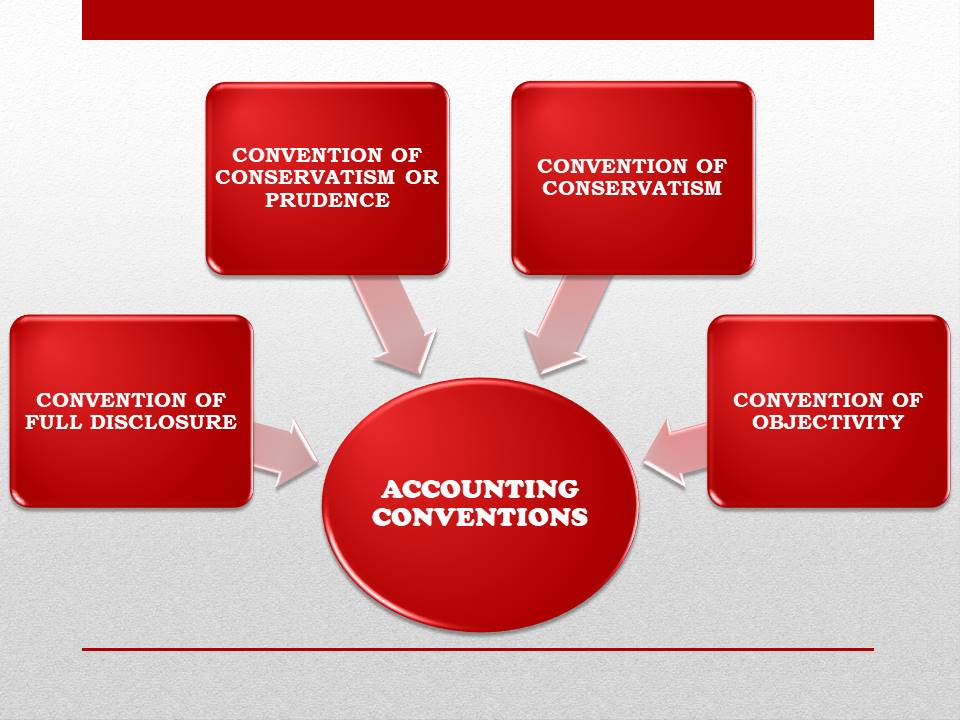ACCOUNTING CONVENTIONS
Accounting conventions are the guidelines based upon custom or usage or general agreement. The accounting conventions are used while maintaining the financial statements by the common consent of the accountants. In the adoption of accounting conventions, the personal judgment plays an important role. There is some kind of logic behind the usage of the conventions. Also there is no uniformity in the adoption of accounting conventions in various business enterprises.
EXAMPLE: The use of ‘TO’ on Debit side with expenses and the use of ‘BY’ on the credit side with incomes is a convention followed in India, UK and other countries but not in the USA.
Following are the various accounting conventions:

CONVENTION OF FULL DISCLOSURE
The convention states that the sufficient and relevant economic information regarding the business operations must be provided or disclosed in the financial statements. The information should serve to the interests of Creditors, Investors, Bankers and Shareholders etc.
The information to be disclosed must comply with the various regulations and provisions of the act in India. If some important information cannot be shown in the Income statement or Balance sheet, then the same should be disclosed by the way of preparing Explanatory Notes or Footnotes. Such as:
- Contingent Liabilities
- The change in the method of valuation
- The change in the method of depreciation
- Market value of Investments, etc.
Disclosing the business information does not mean leaking out the business secrets but disclosing sufficient information which is of material interest to the users of financial statements.
CONVENTION OF MATERIALITY
Convention of Materiality is an exception of the Convention of Full Disclosure. According to this concept, only that information should be disclosed which is relevant or useful for the decision making. In other words, the unnecessary or irrelevant information should not be shown in the books of accounts. The unnecessary information will make the financial statements bulky.
ACCORDING TO KOHLER
“Materiality is the characteristics attaching to a statement, fact, or item whereby its disclosure or the method of giving its expression would be likely to influence the judgment of a reasonable person.”
ACCORDING TO AAA (American Accounting Association)
“An item should be regarded as material if there is reason to believe that knowledge of it would influence decision of informed investor.”
It should be noted that what is material for one business enterprise is immaterial for another business enterprise.
EXAMPLE: The cost of small spare parts may be material for the small workshop, but the same figure is immaterial for the large business house like Escorts Limited.
Similarly, the difference of ₹500 in the valuation of stock may be regarded as immaterial, but the difference of ₹500 in cash could be termed as material.
The accountant should judge the importance of the information to check whether it is immaterial or material.
CONVENTION OF CONSERVATISM OR PRUDENCE
Conservatism is the policy of playing safe. Provision is made for all known liabilities and losses even though the amount cannot be determined with accuracy. The Conservatism or Prudence convention states that:
“ANTICIPATE NO PROFITS, BUT PROVIDE FOR ALL LOSSES”
EXAMPLE: The examples of application of conservatism convention are:
- Closing stock is valued at cost price or market price whichever is less.
- Provision for doubtful debts is created in anticipation of actual bad-debts.
- Joint Life Insurance Policy is shown only at surrender value against the amount paid.
- Provision for a pending law suit against the firm, which may either be decided in its favour.
EFFECT OF CONSERVATISM CONVENTION
This convention should be used very cautiously, otherwise it will have two effects:
- Profit & Loss Account will disclose lower profits in comparison to the actual profits.
- Balance Sheet will disclose understatement of assets and overstatement of liabilities in comparison to the actual values.
CONVENTION OF OBJECTIVITY
Objectivity means reliability and trustworthiness. The accounting information is called objective if it is free from personal bias and judgments. This convention states that the transactions to be recorded in the books of accounts must be supported by some documentary evidence like cash memos, bills, invoices, debit note, credit note etc. Only then the transactions are capable of being verified.
Thanks for the informative article